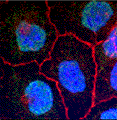Biochemistry, Department of
Document Type
Article
Date of this Version
2-20-2008
Abstract
Pyruvate, orthophosphate dikinase (PPDK) is a ubiquitous, low-abundance metabolic enzyme of undetermined function in C3 plants. Its activity in C3 chloroplasts is light-regulated via reversible phosphorylation of an active-site Thr residue by the PPDK regulatory protein (RP), a most unusual bifunctional protein kinase (PK)/ protein phosphatase (PP). In this paper we document the molecular cloning and functional analysis of the two unique C3 RPs in Arabidopsis thaliana. The first of these, AtRP1, encodes a typical chloroplast-targeted, bifunctional C4-like RP. The second RP gene, AtRP2, encodes a monofunctional polypeptide that possesses in vitro RP-like PK activity but lacks PP activity, and is localized in the cytosol. Notably, the deduced primary structures of these two highly homologous polypeptides are devoid of any canonical subdomain structure that unifies all known eukaryotic and prokaryotic Ser/Thr PKs into one of three superfamilies, despite the direct demonstration that AtRP1 is functionally a member of this group. Instead, these C3 RPs and the related C4 plant homologues encode a conserved, centrally positioned, approximately 260-residue sequence currently described as the domain of unknown function 299¢ (DUF 299). We propose that vascular plant RPs form a unique protein kinase family now designated as the DUF 299 gene family.



Comments
Published in The Plant Journal (2008) 53, 854–863.